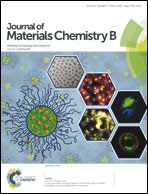Fluorescent ZnO for imaging and induction of DNA fragmentation and ROS-mediated apoptosis in cancer cells†
Abstract
Fluorescein isothiocyanate (FITC)-encapsulated ZnO nanocomposite has been synthesized using the soft chemical approach. X-ray diffraction reveals the formation of highly crystalline single-phase hexagonal wurtzite nanostructure. TEM and SEM micrographs indicate the formation of spherical porous nanoassembly of ZnO of size ∼ 100–400 nm. On the other hand, FITC–ZnO nanocomposite is spherical and porous but with a uniform size of ∼150 nm. The size of single particles is ∼20 nm for the ZnO nanoassembly and ∼15 nm for FITC–ZnO nanocomposite. The UV-visible, fluorescence, FTIR and XPS spectra confirm the formation of FITC–ZnO nanocomposite. The FITC–ZnO nanocomposite demonstrates excellent selectivity in preferential killing of cervical (HeLa) and breast (MCF-7) cancer cells with minimal toxicity to normal fibroblast cells (L929). Apoptotic cells are observed and analyzed by confocal microscopy and flow cytometry. Our results show that cytotoxicity of FITC–ZnO nanocomposite towards cancer cells is due to the generation of reactive oxygen species (ROS) and preferential dissolution of Zn2+ ions in an acidic cancer microenvironment. Furthermore, generated ROS and dissolved Zn+2 ions induce cellular apoptosis, DNA fragmentation, and depolarization of mitochondrial membrane and cell cycle arrest in S phase. The FITC encapsulated multifunctional ZnO nanocomposite can be used as smart nanostructures for cell imaging and cancer therapy.


 Please wait while we load your content...
Please wait while we load your content...